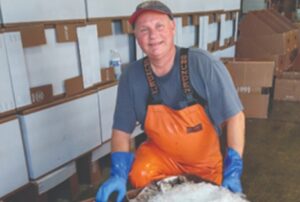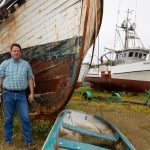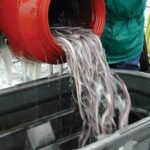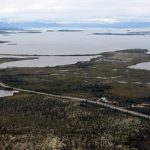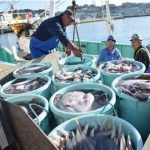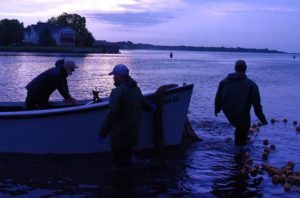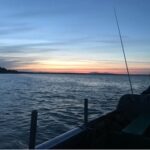FISH-NL asks Ottawa to review quota-sharing arrangements of adjacent stocks – A Letter to Fisheries Minister Wilkinson

The Federation of Independent Sea Harvesters of Newfoundland and Labrador (FISH-NL) has formally asked Ottawa to review the quota-sharing arrangements of all adjacent fish stocks to determine whether the province is the principle beneficiary.
“There should be no difference between the fish and oil off our shores in terms of who the principle beneficiary must be — Newfoundland and Labrador,” says Ryan Cleary, President of FISH-NL. “That’s not the case with species like turbot, halibut, snow crab and scallops, which is unacceptable.”
“Newfoundland and Labrador is slowly losing access to the fish off its shores, which, if not stopped and reversed, will be lethal to the culture and way of life.”
In a letter Tuesday to federal Fisheries and Oceans Minister John Wilkinson, Cleary noted that Canada only holds 15 per cent of the turbot quota on the entire Grand Banks, with the remaining 85 per cent held by counties like the European Union, Japan, and Russia.
In the case of halibut off the island’s south coast, the stock is shared between the Maritimes and Newfoundland and Labrador. Despite being adjacent to the resource, inshore harvesters on the south coast only have access to 2.5 per cent of the quota.
With halibut in the Gulf of St. Lawrence, Quebec has access to more quota than Newfoundland and Labrador and the Maritimes combined. Newfoundland and Labrador’s inshore harvesters have also been squeezed out of two of the most productive scallop beds on the St. Pierre Bank.
Finally, with snow crab in the Gulf Newfoundland and Labrador’s share of the entire Gulf quota is less than 1 per cent. Further, Quebec harvesters can fish directly off Great Northern Peninsula communities like Port Saunders while NL fishermen are blocked from fishing off their own shores.
“FISH-NL requests a formal review of quota-sharing arrangements to examine the fairness of these quotas to harvesters in Newfoundland and Labrador,” Cleary wrote in the letter to the minister, which was forwarded to each of the provincial parties and independent MHAs, “and what steps can be taken to ensure a more equitable stake in the fisheries for inshore harvesters and communities living closest to the resource.”
Contact: Ryan Cleary 682 4862
•••
Tuesday, June 18th, 2019
The Honourable Jonathan Wilkinson
Minister, Fisheries and Oceans Canada
200 Kent St.
Station 15N100
Ottawa, ON
e-mail: [email protected]
Minister Wilkinson,
As President of the Federation of Independent Sea Harvesters of Newfoundland and Labrador (FISH-NL), a union representing upwards of 3,000 inshore harvesters, I’m writing to request an official review of the sharing arrangements for all fish stocks off the province’s shores.
The review would determine whether Newfoundland and Labrador’s inshore harvesters are the principle beneficiary of adjacent stocks*.
A cursory review by FISH-NL reveals that is not the case with many species — including turbot, halibut, snow crab, and scallops.
GREENLAND HALIBUT
In the case of greenland halibut (turbot), Canada holds 15 per cent (1,836 tonnes) of the quota in NAFO fishing zones 3LMNO, which take in the entire nose and tail of the Grand Banks, as well as the Flemish Cap.
The remaining 85% (10,394 tonnes) is held by the European Union, Denmark, the French islands of St. Pierre-Miquelon, Japan, Russia, and other countries.
How is that Canada, as the adjacent state, only has a 15% share of the entire turbot quota in 3LMNO? When the NAFO sharing arrangements for turbot were originally set, what was Canada’s share? If it was higher, and I’m confident it was, what happened to the lost share? Was it traded off, and, if so, what are the details?
3Ps HALIBUT
In the case of halibut off Newfoundland’s south coast, the stock — known as 3NOPs4VW+5 Atlantic halibut — is shared between the Maritimes and Newfoundland and Labrador.
Despite being adjacent to the resource, inshore harvesters in fishing zone 3Ps only have access to 2.5 per cent of this year’s overall total allowable catch (TAC) of 4,789 tonnes. In total, the estimated 700 enterprises in 3Ps have access to only 113 tonnes.
Harvesters in 3Ps went from a halibut bycatch of 10% or 200 pounds a day from April to December a few years ago, to 3% or 200 pounds a day with a 1,500 a pound trip limit and a season that lasts only a few weeks. This sharing arrangement clearly isn’t working as harvesters have thrown back hundreds of halibut — worth tens of thousands of dollars — in a single fishing trip.
Indeed, FISH-NL also calls on Fisheries and Oceans to review its policy on discarding. With very little halibut bycatch, inshore boats have to dump their halibut overboard — dead or alive. Meantime, foreign trawlers operating outside the 200-mile limit can keep whatever halibut they encounter as a bycatch while directing for other groundfish species.
Countries like Iceland do not allow the discarding of fish, and this past January the European Union banned fishing vessels from throwing unwanted fish overboard.
GULF HALIBUT
Moving on to halibut stock in the Gulf of St. Lawrence, Newfoundland and Labrador has been allotted almost a quarter of the 2019 quota of 1,492 tonnes. The breakdown of the sharing arrangements is as follows:
Quebec: 47.5%.
NL: 24.4%.
PEI: 3.9%.
NB: 6.4%.
NS: 8.1%.
With access to 47.5% of the quota, Quebec has access to more of the halibut quota than Newfoundland and Labrador and the Maritimes combined.
GULF SNOW CRAB
Newfoundland and Labrador’s share of the entire Gulf snow crab quota is less than 1%. This year, western Newfoundland harvesters will have access to less than 300 tonnes of snow crab quota in the Gulf, while the total allowable catch for crab in the southern Gulf is 32,480 tonnes.
To rub salt in the wound, Quebec fishermen can fish directly off Great Northern Peninsula communities like Port Saunders while NL fishermen are blocked from fishing off their own shores.
SCALLOPS
The scallop zone on the St. Pierre Bank off southern Newfoundland is divided into northern, middle, and southern beds.
Newfound and Labrador’s inshore fleet once had access to ALL beds, but in the mid-2000s the federal government restricted the fleet to the northern bed, leaving the other two beds to Nova Scotia, and Clearwater’s factory-freezer trawlers.
FISH-NL takes the stand that our inshore fleet should have access to scallops in the middle and southern beds, just as harvesters are allowed to fish all other species — including whelk, cod, skate and sea cucumber — in those areas. The restrictions against our boats are unacceptable.
I remind the Minister that in 2016 the Liberal Party of Canada adopted the adjacency principle — https://winnipeg2016.liberal.ca/policy/adjacency-principle/ — but the Trudeau administration has failed to include adjacency in recent amendments to the federal Fisheries Act.
In fact, adjacency is a longstanding, internationally recognized cornerstone of responsible fisheries management.
FISH-NL requests a formal review of quota-sharing arrangements to examine the fairness of these quotas to harvesters in Newfoundland and Labrador, and what steps can be taken to ensure a more equitable stake in the fisheries for inshore harvesters and communities living closest to the resource.
Yours,
Ryan Cleary,
President, FISH-NL
*”The adjacency criterion requires that priority of access should be granted to those who are closest to the fishery resource in question. The adjacency criterion is based on the explicit premise that those coastal fishing communities and fishers in closest proximity to a given fishery should gain the greatest benefit from it, and on the implicit assumption that access based on adjacency will promote values of local stewardship and local economic development.”
— Report of the Independent Panel on Access Criteria 2002.
cc
MP, Seamus O’Regan ([email protected])
MP, Yvonne Jones ([email protected])
MP, Nick Whalen ([email protected])
MP, Scott Simms ([email protected])
MP, Gudie Hutchings ([email protected])
MP, Ken McDonald ([email protected])
MP, Churence Rogers ([email protected])
c.c. [email protected]
[email protected]
[email protected]
[email protected]
[email protected]
[email protected]

































